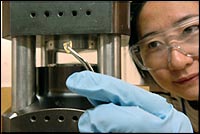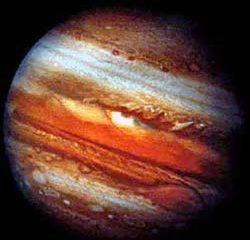This area deals with the fundamental laws and building blocks of nature and how they interact, the properties and the behavior of matter, and research into space and time and their structures.
innovations-report provides in-depth reports and articles on subjects such as astrophysics, laser technologies, nuclear, quantum, particle and solid-state physics, nanotechnologies, planetary research and findings (Mars, Venus) and developments related to the Hubble Telescope.

As NASA’s Cassini spacecraft approached Saturn last July, it found evidence that lightning on Saturn is roughly one million times stronger than lightning on Earth.
That’s just one of several Cassini findings that University of Iowa Space Physicist Don Gurnett will present in a paper to be published Thursday, Dec. 16 in Science Express, an online version of the journal Science, and in a talk to be delivered Friday, Dec. 17 at a meeting of the American Geophysical Union

Aboard Cream, an experiment for the study of cosmic rays
A stratospheric balloon of Nasa was launched yesterday, December 16 at 1.28 a.m. Italian time from the Antarctica’s McMurdo base. The balloon raised Cream (Cosmic Ray Energetics And Mass) experiment up to 40 kilometres of height. In the experiment, coordinated by Eun Suk Seo of Maryland University, participate American universities (Maryland, Chicago, Penn State, Ohio), South Korea universities (Ewa, KyungPook) and an Itali

Dutch researcher Johan Hoogboom has developed a technique for making LCDs (liquid crystal displays) without the need for cleanrooms. This technique is simpler and cheaper than current methods and is based entirely upon the self-ordering of molecules on a surface. Furthermore, the chemist has shown that these LCDs can be used to make DNA visible to the naked eye.
Hoogboom constructed a surface that can align liquid-crystal molecules. For this he designed and produced an aromatic

The Tarantula Nebula is the most vigorous star forming region known in the local Universe. Using the power of the freely available ESA/ESO/NASA Photoshop FITS Liberator package a young amateur astronomer has created this amazing panorama of the centre of the Tarantula. The original image was taken by the NASA/ESA Hubble Space Telescope and subsequently retrieved from the ESO/ST-ECF Science Archive in Munich, Germany.
The Tarantula Nebula, also known as 30 Doradus, is situated 170,0

Glass is a mysterious material, but when researchers apply pressure, it reveals secrets.
Using a variety of techniques, researchers at Argonne National Laboratory saw for the first time ever, the atomic structure of a dense, purely octahedral glass that has eluded scientists for decades. They also witnessed a continuous structural change in the glass, disproving the theory that tetrahedral glasses go through a distinct transition between low- and high-density phases.
“Lit

After eleven months of politics, now it’s time for some real “core values” – not those of the candidates but those of the great gas giant planet, Jupiter.
The planet Jupiter may have a core of tar, according to new reasearch from WUSTL.
Katharina Lodders, Ph.D., Washington University in St. Louis research associate professor in Earth and Planetary Sciences in Arts & Sciences, studying data from the Galileo probe of Jupiter, proposes a new mechanism by which the planet formed